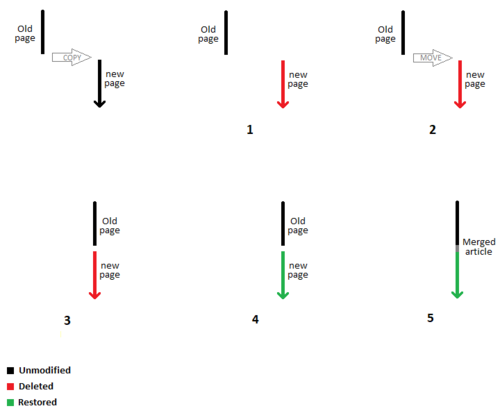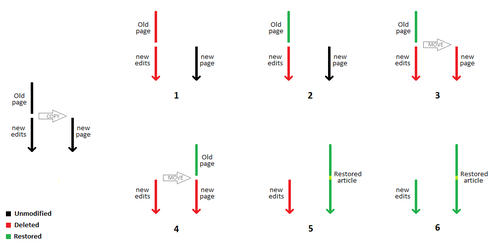|
විකිපීඩියා:How to fix cut-and-paste moves
In the early days of Wikipedia, renamings took place manually, using cut and paste, before the move page function was enabled for non-administrators in August 2002. Now, cut-and-paste moves are usually done by people who are not aware of that function, or when the move function fails (e.g. because the target has history), and people don't know to use the requested moves forum to ask for help from an administrator. When a cut-and-paste move is done, the page history of an article or talk page can be split among two or more different pages. This is highly undesirable, because we need to keep the history with the content for copyright reasons. (See Wikipedia:Copying within Wikipedia). In some circumstances, administrators are able to fix this by merging page histories, using the procedure given below. ඉතිහාස ඒකාබද්ධ කිරීම සඳහා ටැග් එක් කිරීම ගැන උපදෙස්
Repair process (for admins)Warning: this procedure may only be undone by spending quite silly amounts of time. To undo a merge, see below. Do not do this if you're not sure what you're doing. An easy case The following procedure merges the page histories in the case of a hypothetical example: Suppose Alabama/History (old title) was the only article on that subject, and that the article developed in the course of a number of edits, until a decision that History of Alabama (new title) was a better style of name for the article. Suppose further that for whatever reason, the contents of the old article were
(That is, the move tool was not available or not used, to simultaneously transfer the Wiki text and the history of edits to the new title.) And suppose this replacement (new-title) article develops further and reflects the new history of these further edits. Our goal is to graft the (old) edit history from Alabama/History (article with old title) onto the new history in History of Alabama (article with new title) where those partial histories can complement each other. The process is as follows:
Merging page histories of pages with many revisionsSuppose that the page History of Alabama had too many revisions to be deleted or deleting it may cause other disruption. The following procedure can be used to merge page histories in this situation:
A more complex caseSometimes, after a cut-and-paste move is performed, the article at the old title is then edited for some other purpose (e.g. turning it into a disambiguation page). That causes the article now at NewTitle to have part of its history there, and part at OldTitle, but the history at OldTitle also contains the history of NewMeaning. Use of the selective deletion function allows these to be repaired as well.  To select more than one revision for undeletion, click on the tick box of the first revision to be undeleted, then shift-click on the last revision to be undeleted. Every intermediate revision will then be selected. An example of this was Military of Japan; the original was moved to Japan Self-Defense Forces with a cut-and-paste move, and the article Military of Japan was then turned into a disambiguation page. This was repaired with the following procedure:
A troublesome caseHowever, the examples just described only work well if the two pieces of the history of one 'article' are disjoint; i.e. one ends before the other begins. These procedures are inadequate if this condition does not apply, e.g. if the copy of the article at the old title has been edited after the pasting of its contents into the new title. For example, it is not uncommon for:
In this case, the time periods of the two series of edits will overlap. If someone then page-history merges pages A and B using the method described above, the result will sequence the versions of A and B strictly by time, with the result that various versions of A will be interleaved between versions in the page history of page B (and/or vice-versa). Inspecting this merged history without means of distinguishing between the two overlapping progressions (since nothing in this history indicates which version belongs to which sequence) invites severe confusion. An appropriate procedure for such a case is to forego the history merge, and instead handle the situation much like a normal merge; put a note pointing to the other version of the page on the article's talk page. If it is inappropriate to leave the second copy in the main article space, you can archive the duplicate page to Talk: space (i.e. by moving it to some suitable title, such as Talk:RandomArticle/OldVersion). Parallel versionsUsers sometimes send in an ill-advised history-merge request after the two pages involved have been text-merged. If the two pages have separate origins and simultaneous separate parallel histories before they were text-merged, they should not be history-merged, as that would shuffle the parallel editing histories together in one list and make a mess. There is an example in this edit of page Clemson Tigers football. There is an example with 5 incoming pages in this edit of page Wikipedia talk:WikiProject Emo. The best thing to do would be to use the {{Copied}} template and place it on the source and/or destination's talk page. Also, if page A is to be history-merged into page B, before the process, make sure that page B is not sitting over a deleted parallel history, as then deleting B will shuffle the history of B and that deleted history together. The deleted history should first be rescued from under B by some process such as this: Move B to some other name, say B_zxcvbnm (without making a redirect). Undelete B. Move B to some other name, say B/old_version . If necessary, re-delete B/old_version . Move B_zxcvbnm back to B (without making a redirect). Likewise, if a page must be deleted and then partly undeleted for a history-split, first check in case it is sitting over a deleted parallel history. History splittingOver time, articles may change from one underlying topic to a completely separate topic. Normally this should be accomplished through moves and disambiguation pages. However, if a user is unfamiliar with those processes they may simply change the topic of an article (overwriting the old) and continue editing. If this is not caught immediately it is very easy for the new topic to build up a substantial edit history of its own. Admins can use the following steps to fix this problem and maintain separate histories for the separate topics:
How to undo a history mergeIf a history merge should not have been performed, then it may be undone. Note, however, that it can be quite tedious, especially if the article has a very long history. The following procedure is listed:
An example of a successful history merge and undo is available at User:King of Hearts/Sandbox/6 (the A article) and User:King of Hearts/Sandbox/7 (the B article). BugsNote: Due to some minor bugs in the MediaWiki code, article histories may seem to contain anomalies after performing some of the procedures listed below. They are not actual data-base errors, the underlying data is correct; they are just problems with the information displayed. See #Lost history bug for information about these seeming anomalies, and how to deal with them. Lost history bugAfter a history merge, the following peculiarity may be observed: after a successful undeletion, article histories may seem either:
These errors persist even if the browser's "Refresh" button is clicked. These do not seem to be actual database errors, and the underlying data is correct; they are just problems with the information displayed. Note that there seems to be no consistency as to which (if either) of these bugs will appear—expect to see either, or neither. For some users, however, the bug can be cleared with a combination of purging and bypassing browser cache. Work aroundTo see the correct, current, history of the article, select a different history length, e.g. "last 20" or "last 100", instead of the default 50. (Note that this trick only works once; if you do another restore, and the history is messed up again, you will need to select a different, previously unused length, to see the correct, current, history.) Also, making an edit on the page just moved will force the correct history to be shown, so if you have to perform an edit on the target page for some other reasons (e.g. to restore the most recent version, step 4.3 above), this will make the correct history appear. Alternatively, if you don't want to leave things so that a naive user will be confused, make a dummy edit to the page, which will update the history. Former bugsPrevious versions of the Wikimedia software displayed other, similar issues:
These bugs do not seem to be happening any more, but it's worth keeping an eye out for them. See also |
Portal di Ensiklopedia Dunia